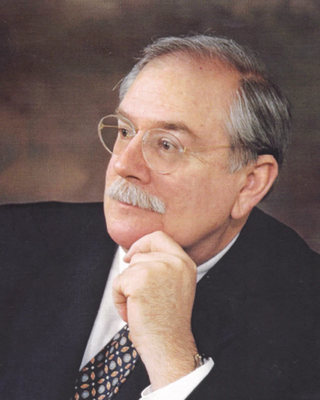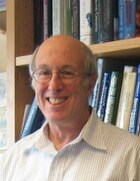
Raymond Urgel Lemieux, CC, AOE, FRS was a Canadian organic chemist, who pioneered many discoveries in the field of chemistry, his first and most famous being the synthesis of sucrose. His contributions include the discovery of the anomeric effect and the development of general methodologies for the synthesis of saccharides still employed in the area of carbohydrate chemistry. He was a fellow of the Royal Society of Canada and the Royal Society (England), and a recipient of the prestigious Albert Einstein World Award of Science and Wolf Prize in Chemistry.

David A. Evans was an American chemist who was the Abbott and James Lawrence professor of chemistry at Harvard University. He was a prominent figure in the field of organic chemistry and his research focused on synthetic chemistry and total synthesis, particularly of large biologically active molecules. Among his best-known works is the development of aldol reaction methodology.

Christopher Abell was a British biological chemist who was a professor of biological chemistry at the Yusuf Hamied Department of Chemistry and Todd-Hamied Fellow of Christ's College, Cambridge. On his 2016 election to the Royal Society, Abell's research was described as having "changed the face of drug discovery."

The avermectins are a series of drugs and pesticides used to treat parasitic worms and insect pests. They are a group of 16-membered macrocyclic lactone derivatives with potent anthelmintic and insecticidal properties. These naturally occurring compounds are generated as fermentation products by Streptomyces avermitilis, a soil actinomycete. Eight different avermectins were isolated in four pairs of homologue compounds, with a major (a-component) and minor (b-component) component usually in ratios of 80:20 to 90:10. Other anthelmintics derived from the avermectins include ivermectin, selamectin, doramectin, eprinomectin, and abamectin.

Sir David Charles Clary, FRS is a British theoretical chemist. He was president of Magdalen College, Oxford, from 2005 to 2020. He was the first chief scientific adviser to the Foreign and Commonwealth Office from 2009 to 2013. He is a Professor of Chemistry at the University of Oxford.
Robert George Bergman is an American chemist. He is Professor of the Graduate School and Gerald E. K. Branch Distinguished Professor Emeritus at the University of California, Berkeley.
Christopher J. Chang is a professor of chemistry and of molecular and cell biology at the University of California, Berkeley, where he holds the Class of 1942 Chair. Chang is also a member of the Helen Wills Neuroscience Institute, a Howard Hughes Medical Institute investigator, adjunct professor of pharmaceutical chemistry at the University of California, San Francisco, and faculty scientist at the chemical sciences division of Lawrence Berkeley Lab. He is the recipient of several awards for his research in bioinorganic chemistry, molecular and chemical biology.
Cynthia Friend is president and chief operating officer of The Kavli Foundation. She is on leave from the department of chemistry and chemical biology at Harvard University. Friend was the first female full professor of chemistry at Harvard, attaining the position in 1989. Friend has held the Theodore William Richards Chiar in Chemistry and served as professor of materials science in the Paulson School of Engineering. She is a member of the National Academy of Sciences, the American Academy of Arts and Sciences and a fellow of the American Association of Arts and Sciences and the American Chemical Society. Her research has focused on nano-science applied to sustainability. Friend and her group have investigated the chemical and physical properties of interfaces, by investigating important catalytic reactions and by making new materials with key chemical functionality. Her lab aims to develop solutions to important problems in energy usage and environmental chemistry.
Goverdhan Mehta FNA, FASc, FTWAS, FRS, FRSC is an Indian researcher and scientist.

James Henderson Naismith is Professor of Structural Biology at the University of Oxford, former Director of the Research Complex at Harwell and Director of the Rosalind Franklin Institute. He previously served as Bishop Wardlaw Professor of Chemical Biology at the University of St Andrews. He was a member of Council of the Royal Society (2021-2022). He is currently the Vice-Chair of Council of the European X-ray Free Electron Laser and Vice-President (non-clinical) of The Academy of Medical Sciences. It has been announced that he will be the Head of the MPLS division at Oxford in the autumn of 2023.
Stephen L. Buchwald is a U.S. chemist and Camille Dreyfus Professor of Chemistry at MIT. He is known for his involvement in the development of the Buchwald-Hartwig amination and the discovery of the dialkylbiaryl phosphine ligand family for promoting this reaction and related transformations. He was elected as a fellow of the American Academy of Arts and Sciences and as a member of the National Academy of Sciences in 2000 and 2008, respectively.

Satoshi Ōmura is a Japanese biochemist. He is known for the discovery and development of hundreds of pharmaceuticals originally occurring in microorganisms. In 2015, he was awarded the Nobel Prize in Physiology or Medicine jointly with William C. Campbell for their role in the discovery of avermectins and ivermectin, the world's first endectocide and a safe and highly effective microfilaricide. It is believed that the large molecular size of ivermectin prevents it from crossing the blood/aqueous humour barrier, and renders the drug an important treatment of helminthically-derived blindness.

David John Wales is a professor of chemical physics in the Department of Chemistry at the University of Cambridge.
Sukh Dev FNA, FASc is an Indian organic chemist, academic, researcher and writer, known for his contributions in the development of Guggulsterone, a plant-derived steroid used as a therapeutic and nutritional agent. He has conducted advanced research in biomedical science and natural products chemistry and holds 55 patents for his findings.
Sasanka Chandra Bhattacharyya (1918–2013) was an Indian natural product chemist and the director of Bose Institute, Kolkata. He was known for his studies on structures and configurations of terpenoids and synthesis of Vetiver Oil and natural musk. He was the vice-president of the Indian National Science Academy and was an elected fellow of the academy as well as the Indian Academy of Sciences. The Council of Scientific and Industrial Research, the apex agency of the Government of India for scientific research, awarded him the Shanti Swarup Bhatnagar Prize for Science and Technology, one of the highest Indian science awards, in 1962, for his contributions to chemical sciences.
Govindasamy Mugesh is an Indian inorganic and physical chemist, a professor and the head of the Mugesh Laboratory attached to the department of Inorganic and Physical Chemistry at the Indian Institute of Science. He is known for his studies on mechanism of thyroid hormone action and is an elected fellow of the Indian Academy of Sciences, Indian National Science Academy, Royal Society of Chemistry and the National Academy of Sciences, India. The Council of Scientific and Industrial Research, the apex agency of the Government of India for scientific research, awarded him the Shanti Swarup Bhatnagar Prize for Science and Technology, one of the highest Indian science awards, in 2012, for his contributions to chemical sciences. In 2019, he was awarded the Infosys Prize in Physical Sciences for his seminal work in the chemical synthesis of small molecules and nanomaterials for biomedical applications.
Rebecca Jane Miriam Goss is a professor of organic chemistry at the University of St. Andrews who won the 2006 Royal Society of Chemistry Meldola Medal. She is known for combining synthetic biology and chemistry for medicinal purposes.

Marcey Lynn Waters is the Glen H. Elder Jr., Distinguished Professor of Chemistry at the University of North Carolina, Chapel Hill (UNC-CH). She is an organic chemist whose research is at the interface of chemical biology and supramolecular chemistry. Waters has received multiple awards for research, teaching, and advocating for women in science. She is serving the President of the American Peptide Society (APS) from 2017 to 2019.
Tylactone synthase or TYLS is a Type 1 polyketide synthase. TYLS is found in strains of Streptomyces fradiae and responsible for the synthesis of the macrolide ring, tylactone, the precursor of an antibiotic, tylosin. TYLS is composed of five large multi-functional proteins, TylGI-V. Each protein contains either one or two modules. Each module consists of a minimum of a Ketosynthase (KS), an Acyltransferase (AT), and an Acyl carrier protein (ACP) but may also contain a Ketoreductase (KR), Dehydrotase (DH), and Enoyl Reductase (ER) for additional reduction reactions. The domains of TYLS have similar activity domains to those found in other Type I polyketide synthase such as 6-Deoxyerythronolide B synthase (DEBS). The TYLS system also contains a loading module consisting of a ketosynthase‐like decarboxylase domain, an acyltransferase, and acyl carrier protein. The terminal Thioesterase terminates tylactone synthesis by cyclizing the macrolide ring. After the TYLS completes tylactone synthesis, the tylactone molecule is modified by oxidation at C-20 and C-23 and glycosylation of mycaminose, mycinose, and mycarose to produce tylosin.
Stephen Neidle is a British X-ray crystallographer, chemist and drug designer working at the UCL School of Pharmacy. His area of scientific research has been in nucleic acid structure and recognition, and the research topic of quadruplexes.









